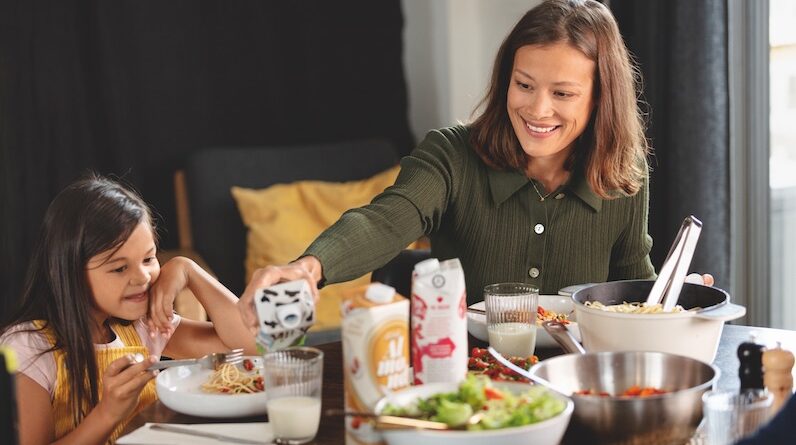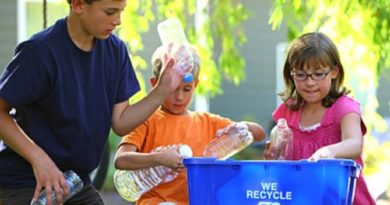
Unlocking circularity through innovation and collaboration
The primary function of food packaging is to protect the food inside, so it can be transported, stored and consumed safely by people across the globe. Today, about 75% of milk sold in Europe is packaged in cartons.1 Shelf-stable packages – called aseptic – play an essential role in the food value chain. Combined with aseptic technology, a solution Tetra Pak introduced 70 years ago, they help keep food safe, nutritious and available – with no preservatives and no refrigeration needed – over months. In addition, aseptic packaging is easing storage, transport, and distribution, allowing producers to reach consumers in remote locations and expand food access.
By extending the shelf life of food, packaging also has the potential to significantly reduce food waste. Combatting food waste is a key component to addressing the climate crisis – 8% of global greenhouse gas emissions are attributed to food waste.2
To put it another way, if food waste were a country, it would be the world’s third largest emitter of emissions.3
Tetra Pak is driven by a specific purpose: to make food safe and available, everywhere, in a way that protects what’s good – protecting food, people and the planet. As a world leading food processing and packaging solutions provider, we are constantly innovating in pursuit of this endeavour – in our own business and across the supply chain – while helping to deliver secure food systems and healthier diets. And we need to achieve this goal whilst operating within environmental boundaries.
As such, we fully embrace the European Union (EU) Green Deal ambitions on climate change, sustainable and resilient food systems, circular economy and biodiversity. As a sector, we provide essential food carton packaging that is mostly sourced, produced and recycled at scale in Europe and, importantly, features a lower carbon footprint than many alternatives, due to its high renewable share.4 It’s good for Europe and good for the economy on which we all depend.
Strengthening the EU’s circular economy requires boosting the local secondary raw materials market, scaling up recyclability of products and reducing waste generation. Our progress depends on driving growth within a sustainable framework by embracing systems thinking, science-based decision making and collaborative innovation.
That is why transparent reporting on how we progress on our net-zero trajectory, whilst enabling a transition towards more sustainable and resilient food systems, is so critical.
Tetra Pak’s commitment to reach net-zero greenhouse gas emissions (GHG)5 is central to our strategy because sustainability is as much our agenda as it is the European agenda. Tetra Pak’s target to reach net-zero greenhouse gas emissions (GHG) across the value chain by 2050 has been approved by Science Based Target initiative (SBTi). We committed to set such a target in October 2021 under the Business Ambition for 1.5°C. For Tetra Pak, this means a 46% reduction of absolute scopes 1, 2 and 3 GHG emissions by 2030, and a 90% reduction across the same set of scopes by 2050.6 To achieve this ambitious goal we have taken a circular approach across our entire business.
Securing circularity in our portfolio
At Tetra Pak, we have chosen to focus on renewability and recyclability to ensure the de-carbonisation and circularity of materials and address the need for sustainable food packaging. We believe this is critical to realise our net-zero target while enabling more resilient and sustainable food systems. Both the EU and we, as an industry, will miss our targets if we do not use the Green Deal’s objective as a guiding principle for all that we do. Therefore, we are accelerating the shift from high carbon, fossil-based materials to low carbon, renewable ones. No less important, those materials also need to be sourced responsibly, to minimise human and societal, as well as environmental, risk, including biodiversity loss.
Tetra Pak cartons are, on average, made of 70% responsibly sourced paperboard.7 Responsible sourcing needs to go hand in hand with transparent reporting, for which we work with leading sustainability assessment platforms.
In 2021, we were the only company in the carton packaging sector to be included in the CDP leadership band for six years in a row, scoring an outstanding double ‘A’ for climate and forest and included in the top 1% of companies taking best practice action to tackle deforestation.8
Recycling contributes to a low-carbon circular economy by keeping valuable materials from post-consumer cartons in use and out of landfills. It helps prevent littering, saves resources, and reduces climate impact.9 We are stepping up work with our value chain and knowledge partners to innovate and share outside-the-box ideas to rethink food packaging from the ground up. The focus of our collaboration is making cartons more attractive for recyclers. In this context, together with our industry partners in the Alliance for Beverage Cartons and the Environment (ACE), we jointly adopted Design-for-Recycling guidelines, which provide technical guidance for to optimise packaging design that is fit for recycling systems.
The role of recyling
Beverage cartons are recyclable. They are collected and recycled at scale where waste management and recycling infrastructure exists. The industry has invested approximately €200 million into inceasing the capacities for beverage carton recycling so far in the European
Union and plans to invest a further €120 million by 2027.10 This ongoing effort translated to a significant growth of the number of facilities that recycle cartons worldwide, from 40 in 2010 to over 170 today.11 The collection of beverage cartons is critical to enable and secure this increase in recycling long-term.
Our aim is to not only invest in recycling, but to develop food packaging made entirely of responsibly sourced renewable or recycled material, that is recyclable and carbon neutral.12
For example, we recently completed a commercial technology validation of a polymer-based barrier to replace the aluminium layer in aseptic cartons. Testing has also started on a new fibre-based barrier – a first within food carton packages distributed under ambient conditions. Alternative materials such as plant-based polymers also provide further opportunity to replace virgin fossil-based plastic with renewable, food contact-safe materials.
A collaborative approach is critical to success
Carton packages already have a lower environmental footprint than many alternatives13. In the European Union, the industry has set itself the 2030 goal to only produce beverage cartons from renewable and/or recycled material, increase the collection for recycling rate to 90% and the recycling rate of beverage cartons to 70%, while driving down carbon at every step of the value chain in line with the 1.5º C target.14 Climate change is a complex and multi-dimensional issue which cannot be solved by one entity or one solution, but we can all contribute. The most critical ingredient for success is collaboration and more partnerships mean faster and more circular solutions. For example, earlier this year, we became the first carton packaging player in the food and beverage industry to launch a cap using attributed recycled polymers.15
An innovation pathway driven by renewability and recyclability is key to addressing the de-carbonisation and circularity of materials and the need for environmentally-sound food packaging.
And collaboration doesn’t end with packaging, it’s also key to reducing waste in the food system. We have joined forces with several innovative companies to transform potential food waste into sources of nutritious food, as well as developing alternative protein-based food applications. We are also advancing co-operation projects to reinvent food production in a circular way, including to upcycle food waste and by-products from production. But it isn’t just about reinventing existing foods, ecological pressure requires innovation to go beyond the bounds of existing systems. The goal here is to find alternative food sources that can yield higher output with low environmental impact.
Looking ahead
To meet the challenge of responsible production and consumption as set down by the UN’s Sustainable Development Goal 12, and ensure we play our part in ensuring a circular economy in Europe, it has become more important than ever for us to use more sustainable materials, improve food production and availability, and increase innovations in techology to avoid food waste.
The private sector is key to making the EU Green Deal a reality and success: to reach climate neutrality by 2050, we will need deep emission cuts across all sectors. Therefore, in the long term, the Green Deal will largely depend on industrial transformation and innovative solutions.
Looking ahead, it is essential to foster an open innovation ecosystem to catalyse change and help transform the food processing and packaging industry on circular principles, whilst also ensuring that food is safe and available to all. In this context, European policy for food and packaging needs to be coordinated to enable and incentivise innovation to contribute to meeting ambitious objectives for essential food packaging.
___________________________________________________________
2 FAO’s Food Wastage Footprint & Climate Change
3 FAO’s Food Wastage Footprint & Climate Change
4 ifeu 2020, “Comparative Life Cycle Assessment of Tetra Pak® carton packages and alternative packaging systems for beverages and liquid food on the European market”.
5 Tetra Pak’s net-zero trajectory builds on a combination of reduction and mitigation of emissions in the company’s own operations, its supply chain and from the use of its products, and compensation of residual emissions via the company’s nature conservation programme.
6 https://www.tetrapak.com/sustainability/planet/environmental-impact/a-value-chain-approach
7 Responsible sourcing | Tetra Pak
8 Tetra Pak Sustainability Report 2022 for download | Tetra Pak
9 Tetra Pak Sustainability Report 2022 for download | Tetra Pak
11 https://www.tetrapak.com/about-tetra-pak/stories/eliminating-food-packaging-waste
12 We aim to deliver the world’s most sustainable food package, a carton package made of renewable or recycled materials, that are responsibly sourced, therefore helping protect and restore our planet’s climate, resources and biodiversity; contributing towards carbon-neutral production and distribution; convenient and safe, therefore helping to enable a resilient food system; fully recyclable.
13 ifeu 2020, “Comparative Life Cycle Assessment of Tetra Pak® carton packages and alternative packaging systems for beverages and liquid food on the European market”.
14 Tetra Pak Sustainability Report 2022 for download | Tetra Pak
15 https://www.tetrapak.com/about-tetra-pak/news-and-events/newsarchive/worlds-first-tethered-caps-carton-packages. The attributed recycled polymers used in Tetra Pak carton packages are certified by the Roundtable on Sustainable Biomaterials (RSB), according to principles of attribution (RSB Advanced Products Category III).




